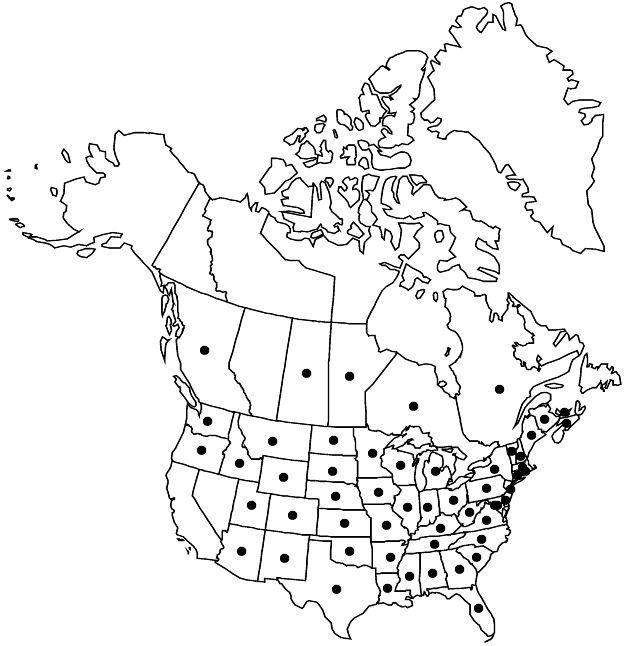Difference between revisions of "Oxalis dillenii"
Oxalis, 28. 1794.
FNA>Volume Importer |
imported>Volume Importer |
||
| (One intermediate revision by the same user not shown) | |||
| Line 79: | Line 79: | ||
|publication year=1794 | |publication year=1794 | ||
|special status=Weedy;Endemic | |special status=Weedy;Endemic | ||
| − | |source xml=https:// | + | |source xml=https://bitbucket.org/aafc-mbb/fna-data-curation/src/2e0870ddd59836b60bcf96646a41e87ea5a5943a/coarse_grained_fna_xml/V12/V12_628.xml |
|genus=Oxalis | |genus=Oxalis | ||
|species=Oxalis dillenii | |species=Oxalis dillenii | ||
Latest revision as of 19:16, 5 November 2020
Herbs perennial, caulescent, rhizomes present (sometimes appearing taprootlike), stolons absent, bulbs absent. Aerial stems (1–)2–8 from base, erect initially, often becoming decumbent or prostrate and stolonlike, rarely rooting at nodes, 10–25 cm, usually herbaceous, sometimes becoming woody proximally, densely and evenly strigillose to strigose from base to peduncles and pedicels, hairs straight, antrorsely appressed, nonseptate, sharp-pointed. Leaves basal and cauline; stipules oblong, margins narrowly flanged or without free portions, apical auricles absent; petiole 1–4 cm, hairs nonseptate; leaflets 3, green, obcordate, (4–)6–15(–21) mm, lobed 1/5–1/3 length, abaxial surface sparsely strigillose, adaxial surface glabrous, oxalate deposits absent. Inflorescences usually umbelliform cymes, rarely irregular cymes, 1–3(–8)-flowered; peduncles 1–6(–10) cm. Flowers mostly homostylous; sepal apices without tubercles; petals yellow, without red lines, (2.5–)4–8 mm. Capsules angular-cylindric, abruptly tapering to apex, 12–20(–25) mm, densely strigose-pilose, hairs both appressed and spreading, with puberulent understory. Seeds brown, transverse ridges with strong grayish or white lines. 2n = 18, 20, 22, 24.
Phenology: Flowering Feb–May(–Oct).
Habitat: Pastures, roadsides, lawns, river bottoms, sandy, rocky, or gravelly soils.
Elevation: 0–300 m.
Distribution

B.C., Man., N.B., N.S., Ont., P.E.I., Que., Sask., Ala., Ariz., Ark., Colo., Conn., Del., D.C., Fla., Ga., Idaho, Ill., Ind., Iowa, Kans., Ky., La., Maine, Md., Mass., Mich., Minn., Miss., Mo., Mont., Nebr., N.H., N.J., N.Mex., N.Y., N.C., N.Dak., Ohio, Okla., Oreg., Pa., R.I., S.C., S.Dak., Tenn., Tex., Utah, Vt., Va., Wash., W.Va., Wis., Wyo., introduced in Bermuda, Europe.
Discussion
Decumbent stems of Oxalis dillenii often appear stolonlike, producing erect branches and leaves at the nodes, rarely producing a few adventitious roots. Such plants sometimes are misidentified as O. corniculata, but they differ in their overall habit, stems and rhizomes that become woody, reduced stipules, strigillose cauline vestiture, denser fruit vestiture, and seed color. Plants of O. dillenii in Canada and the western United States appear to be adventive.
Plants of Oxalis dillenii flowering into November and December in Texas and North Carolina, and probably elsewhere, characteristically are depressed in habit, with creeping stems and forming matlike colonies. The corollas are small, with petals 2.5–3 mm. Although similar in habit to typical O. corniculata, these plants do not have stems that root at nodes, and the strigillose vestiture, though reduced in density, and the stipule morphology are like O. dillenii. Whether these are the same genotype as spring-flowering plants or a different entity remains to be investigated. At least some of the variability in O. dillenii, particularly in habit, may be genetically partitioned, as dysploid chromosome races apparently exist.
Selected References
None.